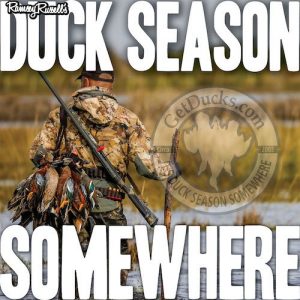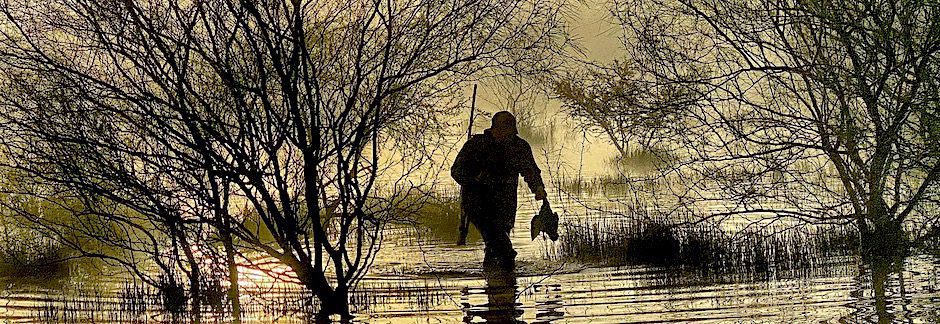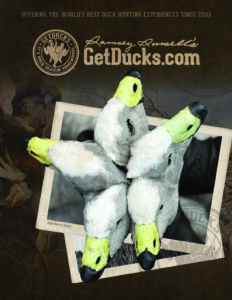MOJO’S Duck Season Somewhere Podcast
Ringneck Resort, North Dakota Pheasant Hunting Combo

Ramsey shifts gears during the 2020-2021 North American Waterfowl Tour – and after a couple weeks sitting in duck and goose blinds, stretching his legs to chase North Dakota pheasants feels great! Todays guests, Ringneck Resort’s Shaine Swenson and Clayton Mayer talk about their own hunting origins and what it takes to organize a hunt like this. What advantages does North Dakota offer over South Dakota? What’s a normal hunting day like and why are they flexible? When do the seasons run? How does Ramsey describe the hunting them, and what left a particularly smelly impression? What are some favored ways for cooking pheasants? It’s another great Duck Season Somewhere episode from the never-ending road! Related Links: Ringneck Resort, North Dakota Pheasant Hunting Combo
Holt Collier, Legendary Mississippi Bear Hunter (Part 2)

Holt Collier’s hunting reputation has achieved heroic proportions. His circle of friends includes governors, generals, senators. But along with the railroads to whom Collier has supplied bear meat comes the clearcutting of the region’s virgin forests and subsequent decimation of bear populations. But it’s when Collier transitions from market hunter to bear guide that he garners the attention of the most famous big game hunter in America. What was the most perilous event during Collier’s bear hunting career? Why did President Teddy Roosevelt come to hunt bears with Holt Collier in the Mississippi Delta, and what events transpired to make it one of the most heavily sensationalized media events of the year? What was the relationship among Roosevelt, President of the United States, and Collier, former slave and bear guide? What became of the world and the lifestyle that Collier knew? Ramsey joins Minor F. Buchanan, author of Holt Collier: His Life, His Roosevelt Hunts, and the Origin of the Teddy Bear, and Mississippi Delta storyteller Hank Burdine, for the finale of this incredible 2-part story about a people, time and place forever lost.
North Dakota Waterfowl Hunting, Of Dirty Bird Outfitters and Hamburger Hills

It’s unseasonably single-digit windchills and bone-chilling cold when Ramsey Russell goes North dakota waterfowl hunting with Dirty Bird Outfitters’ Nick Marcyes for their 3rd- or 4th Annual “Where’s-Matt-At Hunt” together in North Dakota – way different than preceding visits! Undeterred, Nick rolls with the punches and develops a winning game plan for DBO guests. What did Canadian border closures do to license sales in North Dakota and could Nick tell a difference? How do the ducks and geese respond to these unseasonable cold snaps and what’s a good game plan for dealing with? What duck species besides mallards did they shoot this time? Why does Nick think they didn’t kill a leg band during this year’s visit? The 2020-2021 North America Waterfowl Tour continues in this fun episode.
Related Links:
Former Federal Wildlife Agent, Lifetime Mississippi Duck Hunter

Today’s anonymous guest credits duck hunting back in Mississippi’s South Delta – that required long, gumbo mud hikes with his dad, across bean fields that stretched for as far as he could see – for his developing an appreciation for “working smarter not harder.” He recalls the expansion of federal refuges in the Mississippi Delta and, as one of their employees, public relations fiascos and law enforcement challenges. What was it like hunting the Mississippi Delta back in the good ol’ days? How’d he start working in federal law enforcement, and what happened when the federal government turned private hunting clubs into federal refuges? What was the most memorable thing said in his presence while a hunting guest at duck camps in Mississippi? What was the infamous “1:30 Hole”, and fate likely befell this magical spot? Being a life-long duck hunter and wearing a federal agent badge formed fascinating perspectives that he shares in today’s great episode.
Holt Collier, Legendary Mississippi Bear Hunter (Part 1)

Holt Collier is among the most legendary figures in American hunting history that you’ve probably never even heard of. Proving once and for all that truth is stranger than fiction, and far more interesting, the story takes place in a primordial Mississippi delta wilderness that was vanquished during Collier’s lifetime. Born a slave, Collier later became closely associated with some of the most powerful political figures in America through his unrivaled reputation as a hunter. What was Holt Collier’s childhood like, and how’d he develop legendary shooting skills? How old was he when he killed his first bear? How’d Collier spend his time during the Civil War, and what huge opportunity developed during Reconstruction that put Collier on the path to becoming a hunter of heroic proportions? Ramsey joins Minor F. Buchanan, author of Holt Collier: His Life, His Roosevelt Hunts, and the Origin of the Teddy Bear, and Mississippi Delta storyteller Hank Burdine, for the telling of this epic 2-part story about a people, time and place forever lost.
Where Waterfowl Hunting and Science Converge

File this one under interesting things learned in a duck blind during Ramsey’s 2020-2021 North American Tour. Following a fun diver hunt among friends in blustery North Dakota, where lively duck blind banter ensued between volleys, Ramsey and Chris Nicolai warm their fingers around cups of hot coffee back at camp where they get down to the serious business of talking waterfowl management and implications. Nicolai is now Waterfowl Scientist at Delta Waterfowl. Formerly with US Fish and Wildlife Service, he’s a renowned waterfowl biologist with 20 years experience conducting elite-level waterfowl research. Importantly, he’s an ardent, lifelong waterfowl hunter. The conversation tears like a bluebill with a tailwind through a variety of interesting topics such as (Pacific) black brant, recreational hunters’ conservation role, northern pintails – you’ll probably want to pay especially close attention to this part boys and girls – and more! Who is Nicolai, how’d he get started hunting, how’d he become a serious waterfowl biologist? What’s the purpose of banding waterfowl, and why are black brant of particular interest? How many North American waterfowl species has Nicolai handled/banded, and what are some of most interesting places he’s conducted field research worldwide? Why is the pintail limit only 1 daily in the Lower-48, why hasn’t this iconic species responded to decades of restrictive harvest regulations, and what are the scientific justifications for a newly proposed 3-pintail daily bag limit?! Today’s Duck Season Somewhere episode is a heavy hitting conversation!
Related Links:
Old School North Dakota Divers

It’s snowing and blowing, temps plummeting North Dakota-style when I wheel into Jeff Pelayo’s driveway during the 2020-2021 North American Waterfowl Tour. North Dakota duck hunting usually conjures mental imagery of mallards and Canadas pouring into dry fields, but I’m meeting Jeff to experience a lesser-seen-side of this cowboy state: diver ducks. Bluebills, canvasbacks, redheads, buffleheads, ring-necked ducks, occasional goldeneyes are Pelayo’s obsession. The way he hunts them harkens a bygone era. I get my first inkling of this after entering his prairie lakeside home. At first glimpse it resembles a waterfowl decoy museum – until I notice that most of his decoys are rigged for action. What are Pelayo’s duck hunting origins? How’d he go from banding Stellar’s eiders in Alaska to owning a collectible waterfowl gallery along Maryland’s Eastern Shore? Why’d he “swear off plastics” in the pursuit of diver ducks, and why do old school methods mean so much to him? Like a bluebill ripping off open water into a protected cove of soaking wood duck decoys, this fascinating episode speaks genuine American Dreaming.
Vanishing Paradise

In the final episode of Warren Coco series, Ramsey Russell and Warren Coco shift gears and discuss Louisiana Gulf Coastal restoration. There have been significant habitat changes in Louisiana during time span that this 8-part series took place, not the least of which are the “sinking lands” in the Lower Mississippi River Delta, especially, and parts of the entire Gulf Coast. Disappearing at an estimated rate of a football size field of area per hour, advocacy groups have declared it a Vanishing Paradise. Of what value is this habitat resource to humanity and wildlife? Why is the land sinking, disappearing? What solutions exist for it’s restoration? How does Coco use his understanding of these processes to protect his marsh area near Hackberry? What are government agencies doing – or not doing? Coco will likely be back in the future, but gives us plenty to think about until then.
Related Links:
Wisconsin “Ten Yarders”

The 2020 North American Waterfowl Tour continue as Ramsey Russell wheels into Wisconsin during an October snow storm and shares a couple great Wisconsin honker hunts with “TJ Ten Yards.” TJ describes his earliest goose hunting influences, why giant Canada geese are his favorite. TJ came by his nickname the old-fashioned way – he earned it. Like a talkative 9-pack of longnecks sailing towards the spread on locked wings, his proven Canada goose hunting game plan philosophy is worth paying close attention.
10-Gauge Shotgun Talks

Throughout the United States a sub-gauge movement seems underway as more waterfowlers are shouldering 20- and 28-gauge small-bores instead of 12-gauge shotguns. Which is why Ramsey Russell found it so surprising that legendary duck hunter Warren Coco oftentimes shoots the tried-and-true 10-gauge shotgun at ducks. Why did Coco begin shooting a Big Ten? How have shotshells changed since the “good old days?” What are Coco’s thoughts on non-toxic shotshells versus lead? This episode packs a real wallop as these and other topics are discussed.








